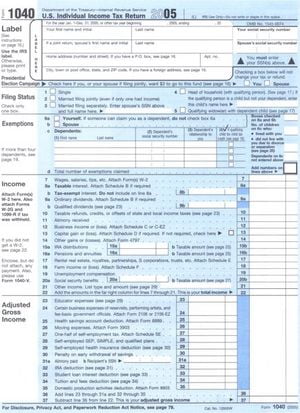The IRS imposes penalties to enforce compliance with tax laws, and charges interest and penalties on unpaid taxes that are owed. There are various types of penalties that the IRS can impose for different reasons. The amounts of the penalties vary, and are generally related to the seriousness of the noncompliance.
Late filing penalty
If you are in doubt about filing your federal income tax return when you owe taxes and don’t have the money to pay, you should file anyway. You will be charged a penalty and interest for late payment, but at least you won’t be charged a penalty for not filing, or for late filing. The penalty for late filing is 5% per month of the balance of tax owed. This penalty accumulates month by month up to a maximum of 25% of the balance of tax owed. If your return is more than 60 days late, the minimum penalty is the smaller of $100 or 100% of the tax owed.
Late payment penalty
If you file on time but don’t pay the balance of tax you owe, you will generally be charged a late payment penalty of 0.5% of the tax owed for each month, or part of a month, that the tax remains unpaid, up to 25% of the balance owed. After the IRS has issued a notice of intent to levy, this monthly penalty rate goes up to 1%.
If you paid the taxes you owed when you filed your return, but the IRS makes a correction to your return and you owe additional taxes, you will be charged a late payment penalty and interest on the additional amount owed.
Interest
Interest, compounded daily, is charged on the balance of tax owed, from the due date of the return until the date of payment. The interest rate the IRS charges is adjusted each quarter, and for individuals the rate is the federal short-term rate plus 3 percent. The IRS announced in March 2008 that the rate for the quarter beginning April 1, 2008 will be 6%.
It is important to note that interest is calculated on the unpaid balance of tax owed plus the penalties and interest that have been charged. When making payments through an installment agreement with the IRS, penalties and interest continue to accrue on the unpaid portion of the debt. For this reason, the IRS itself advises that it may be advantageous to take out a bank loan or use a cash advance from a credit card to pay the balance of taxes owed, if the interest rate is lower than the combination of penalties and interest imposed by the IRS. This is illustrated on the IRS website at www.irs.gov, under “How Borrowing Money to Pay Your Taxes Could Cost You Less Than an Installment Agreement”.
When you are due a refund
If you do not file a return on time and you are due a refund, there is no penalty for late filing. But you should keep in mind that you can only claim a refund for up to three years from the original due date for filing. After that time you can no longer claim the refund.
When you apply for an extension
When you file Form 4868 to apply for an automatic extension of time to file your return, you will not be subject to a late payment penalty during that extended period if you have paid at least 90% of your actual tax liability by the regular due date of your return, through withholding, estimated tax payments, or the payment you make when you file Form 4868.
Underpayment penalty
The IRS points out that the income tax is a pay-as-you-go tax, and they will charge you an underpayment penalty if you did not have enough tax withheld from your pay, or you did not make enough estimated tax payments during the year to cover your tax obligation. Most taxpayers can avoid this penalty if they have paid at least 90% of their tax during the year, or 100% of the tax shown on their return for the prior year, whichever is smaller.
The underpayment penalty takes the form of interest on the underpayment. When you are making estimated tax payments during the year, the penalty is calculated based on your tax liability for each period. So you may have to pay the penalty on your estimated payment for one period even if you later paid enough to cover the underpayment. And in fact, you can incur an underpayment penalty, based on the estimated payment periods, even when you end up with a refund when you file your annual income tax return.
The underpayment penalty is calculated on Form 2210, Underpayment of Estimated Tax by Individuals, Estates, and Trusts. When you owe this penalty you must complete Form 2210 and include it with your tax return.
Accuracy-related penalty
A 20% accuracy-related penalty is applied when the tax you report on your return is significantly lower than the correct amount of tax, and the underpayment is due to negligence or disregard of rules or regulations. Negligence includes the lack of any reasonable attempt to comply with the tax laws, and disregard includes the careless, reckless, or intentional disregard of rules or regulations.
The penalty is also applied for a substantial understatement of income tax, which means that the tax as shown on the return you filed is less than the correct amount of tax, and the understatement exceeds the greater of 10% of the correct tax, or $5,000.
This penalty may be reduced if there is substantial authority for the tax treatment you used. This depends on the facts and circumstances, and the IRS will take into consideration revenue rules and procedures, court opinions, and notices and announcements published in the Internal Revenue Bulletin that involve cases or circumstances similar to yours.
The penalty may also be reduced if you have adequately disclosed the relevant facts regarding your tax treatment, and you have a reasonable basis for using that treatment. You can use IRS Form 8275, Disclosure Statement, for this purpose. You should use Form 8275-R, Regulation Disclosure Statement, to disclose positions you are taking that are contrary to regulations.
Penalty for frivolous return
Filing a frivolous return will result in a penalty of $500, in addition to any other penalties and interest that apply. A frivolous return is one that does not include enough information to figure the correct tax, and that indicates a frivolous position on your part, or a desire to delay or interfere with the administration of federal income tax laws. The IRS points out that if an idea to save on taxes seems too good to be true, it probably is.
Fraud
The penalty for filing a fraudulent return is 75% of the underpayment due the IRS that is attributable to fraud. The penalty for late filing due to fraud is 15% per month of the net amount of taxes due the IRS, up to a maximum of 75%.
There could also be criminal penalties for fraud and false statements, willful failure to file a return, provide information, or pay any tax due, and for tax evasion.
Reference:
- Alvin Brown & Associates – Background Information on IRS Tax Penalty: www.irstaxattorney.com






